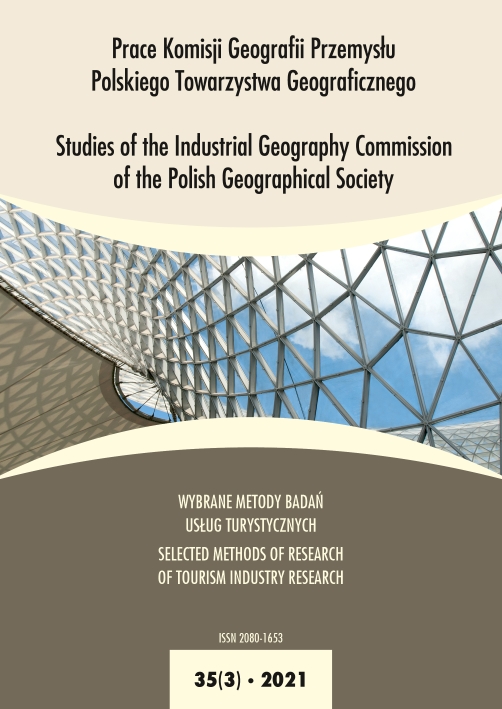The impact of COVID-19 pandemic on foreign tourism in European countries
DOI:
https://doi.org/10.24917/20801653.353.11Keywords:
COVID-19, Europe, Perkal’s index, pandemic, tourismAbstract
The subject of this study is the COVID-19 pandemic that has shaken the world’s tourism industry since March 2020. The aim is to propose the use of the Perkal index to assess the impact of the pandemic on tourism in European countries. Five variables from the UNWTO and Eurostat were used in the research and they concerned thirty European countries. These variables are: data on the percentage change in nights spent at tourist accommodation establishments, percentage change in international tourist arrivals, percentage change in international tourism receipts, percentage change in persons employed in tourism, and percentage change in net occupancy rate of bed-places and bedrooms in hotels and similar accommodation. On the basis of the Perkal index value, it is evident that the crisis of 2020 affected the countries located in the Mediterranean (including Italy and Greece) to a largest extent. On the other hand, the pandemic least influenced the Scandinavian countries, the Baltic countries and those located in the central part of the European continent. The proposed index allows to evaluate changes in a time series system and enables comparative analysis between territorial units. In both international and domestic comparisons, the impact of COVID-19 on tourism assessment index may be a useful analysis tool and is likely to be widely used in the future.
Downloads
Metrics
References
Altuntas, F., & Gok, M.S. (2021). The effect of COVID-19 pandemic on domestic tourism: A DEMATEL method analysis on quarantine decisions. International Journal of Hospitality Management, 92. doi: 10.1016%2Fj.ijhm.2020.102719
Chrobocińska, K. (2021). Comparative Analysis of Regional Competitiveness in Poland from 2010–2019 in the Context of the Concept of Sustainable Development. Sustainability, 13(6). doi: 10.3390/su13063202
Eurostat. (2021a). Nights spent at tourist accommodation establishments - monthly data. https://ec.europa.eu/eurostat/databrowser/product/page/TOUR_OCC_NIM
Eurostat. (2021b). Employed persons by full-time/part-time activity and NACE Rev. 2 activity. Retrieved from https://ec.europa.eu/eurostat/databrowser/view/tour_lfs1r2/default/table?lang=en
Eurostat. (2021c). Net occupancy rate of bed-places and bedrooms in hotels and similar accommodation. Retrieved from https://ec.europa.eu/eurostat/databrowser/view/TOUR_OCC_MNOR__custom_987792/default/table?lang=en
Hwang, C.L., & Yoon, K. (1981). Methods for multiple attribute decision making. In: Multiple attribute decision making. Berlin, Heidelberg: Springer, 58-191. doi: 10.1007/978-3-64248318-9_3
Ilieş, A. & Wendt, J.A. (2015). Geografia turystyczna. Podstawy teorii i zagadnienia aplikacyjne. Gdańsk: Wydawnictwo AWFiS.
Karabulut, G., Bilgin, M.H., Demir, E., & Doker, A.C. (2020). How pandemics affect tourism: International evidence. Annals of Tourism Research, 84 . doi: 10.1016%2Fj.annals.2020.102991
Korinth, B. (2020). The impact of COVID-19 on foreign travel plans of Polish tourists, 2020. Studia Periegetica, 32 (4), 59–69. doi: 10.5604/01.3001.0014.6585
Kousi, T., Mitsi, L.C., Simos, J. (2021). The Early Stage of COVID-19 Outbreak in Greece: A Review of the National Response and the Socioeconomic Impact. Int. J. Environ. Res. Public Health, 18, 322. doi: 10.3390/ ijerph18010322
Kufel, T. (2020). ARIMA-based forecasting of the dynamics of confirmed Covid-19 cases for selected European countries. Equilibrium. Quarterly Journal of Economics and Economic Policy, 15(2), 181–204. doi: 10.24136/eq.2020.009
Kurkiewicz, J., Pociecha, J., & Zając, K. (1991). Metody wielowymiarowej analizy porównawczej w badaniach rozwoju demograficznego. Monografie i Opracowania/Szkoła Główna Handlowa, (336).
Kwiatek-Sołtys, A., & Bajgier-Kowalska, M. (2019). The role of cultural heritage sites in the creation of tourism potential of small towns in Poland. European Spatial Research and Policy, 26(2), 237–255. doi: 10.18778/1231-1952.26.2.11
Lee, C.C., & Chang, C.P. (2008). Tourism development and economic growth: A closer look at panels. Tourism management, 29(1), 180–192. doi: 10.1016/j.tourman.2007.02.013
Lewandowska, A., & Szymańska, D. (2021). Ecologisation of Polish cities in the light of selected parameters of sustainable development. Sustainable Cities and Society, 64 . doi: 10.1016/j.scs.2020.102538
Liu, A., Vici, L., Ramos, V., Giannoni, S., Blake, A. (2021). Visitor arrivals forecasts amid COVID-19: A perspective from the Europe team. Annals of Tourism Research, 88, 103182. doi: 10.1016/j.annals.2021.103182
Moreno-Luna, L., Robina-Ramírez, R., Sánchez, M.S.-O., Castro-Serrano, J. (2021). Tourism and Sustainability in Times of COVID-19: The Case of Spain. Int. J. Environ. Res. Public Health, 18, 1859. doi: 10.3390/ijerph18041859
Parysek, J.J., & Wojtasiewicz, L. (1979). Metody analizy regionalnej i metody planowania regionalnego. Studia KPZK PAN, t. 39. Warszawa: PWN.
Ridderstaat, J., Singh, D., & DeMicco, F. (2019). The impact of major tourist markets on health tourism spending in the United States. Journal of destination marketing & management, 11, 270–280. doi: 10.1016/j.jdmm.2018.05.003
Smith, D.M. (1972). Geography and social indicators. South African Geographical Journal, 54(1), 43–57. doi: 10.1080/03736245.1972.10559497
UNWTO. (2021). World tourism barometer, vol. 19(1), January 2021. doi: 10.18111/wtobarometereng
Walas, B. & Kruczek Z. (2020). The impact of COVID-19 on tourism in Kraków in the eyes of tourism entrepreneurs. Studia Periegetica, 2(30), 79–95. doi: 10.5604/01.3001.0014.3664
Wendt, J.A., Grama, V.; Ilieş, G., Mikhaylov, A.S. Borza, S.G. Herman, G.V. & Bógdał-Brzezińska, A. (2021). Transport Infrastructure and Political Factors as Determinants of Tourism
Development in the Cross-Border Region of Bihor and Maramureş. A Comparative Analysis. Sustainability, 13, 5385. doi: 10.3390/su13105385
Więckowski, M. (2020). Can pandemic stop or slow the Anthropocene? Geographia Polonica, 93(4), 473–492. doi: 10.7163/GPol.0183
Więckowski, M. (2021). Will the Consequences of Covid-19 Trigger a Redefining of the Role of Transport in the Development of Sustainable Tourism? Sustainability, 13, 1887. doi: 10.3390/su13041887
Wöber, K.W. (2000). Standardizing city tourism statistics. Annals of Tourism Research, 27(1), 51–68. doi: 10.1016/S0160-7383(99)00054-7
Zhang, H., Song, H., Wen, L., & Liu, C. (2021). Forecasting tourism recovery amid COVID-19. Annals of Tourism Research, 87, 103149. doi: 10.1016/j.annals.2021.103149
Downloads
Published
How to Cite
Issue
Section
License

This work is licensed under a Creative Commons Attribution-NoDerivatives 4.0 International License.
Articles are published under the terms of the Creative Commons License (CC BY-ND 4.0; Attribution– NoDerivs).

